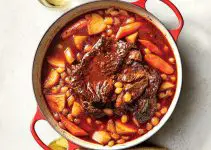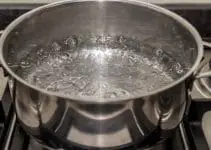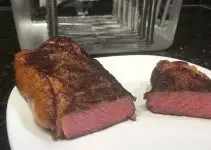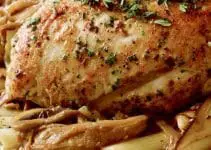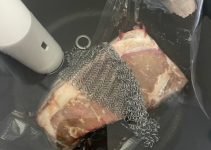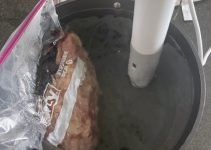Table of Contents
Thinking about vacuum sealing your foods to experience the benefits of sous vide? Awesome! Sous vide is the most accurate and consistent form of cooking as it’s almost impossible to overcook your food.
However, there are a few drawbacks to watch out for.
Below, we’ll cover six cons to vacuum sealing that you should consider before starting your sous vide journey. I’ll also answer some frequently asked questions to help you decide if sous vide is for you.
You Need To Plan Ahead
The biggest struggle with sous vide is that you need to plan a day before the time. This is because many sous vide meals require a few hours in the bath before it’s ready. If you can cook a chicken in five minutes, you’ll have to wait at least one hour with sous vide.
So if you’re looking to whip something up within a few minutes, sous vide isn’t for you. Instead, you’ll have to sear your steak, chicken, or vegetables.
But this makes vacuum sealing foods a good option for meal preppers. You won’t have to spend time in the kitchen cooking steak. Simply pop your meal in the sous vide bath and carry on with your day.
It Takes a Long Time to Get the Right Temperature
You can get your pan up to temperature when searing steaks or vegetables after two or three minutes. But with sous vide, you’ll have to wait at least 15 minutes before putting your food in the sous vide bag.
Food Safety
Until a few years ago, professional chefs were the only people that used sous vide machines. These individuals study for years to prepare the best meals, and they learn about food safety along the way.
The problem is that home cooks only understand the basics of food safety, like washing your food, separating it, and keeping it outside the temperature range of bacteria. But we aren’t experts and don’t know everything about cooking with plastics.
So before you start your sous vide journey, you’ll have to learn everything you can about food contamination and cooking with vacuum sealed plastic bags. This can take up a lot of time, and it’s not worth it if you aren’t passionate about cooking.
It’s Boring
Cooking meals are just as enjoyable as eating them. It’s a sensory experience mixing different meats, vegetables, and spices to create something special. This is what draws many towards the art of cooking.
Unfortunately, vacuum sealing foods aren’t exciting. There’s not much you can do other than seal and marinate your food and place it in your sous vide bath.
Many home cooks also believe that although it produces better results, vacuum sealing takes the joy out of cooking, so they stick with traditional methods. But this is a personal preference, and everyone has their own style of cooking.
It Requires Special Equipment
If you want to sear or boil your food, everything you need is already in your kitchen. But you’ll have to buy special tools when cooking sous vide style:
- A vacuum sealer
- An immersion circulator
- Sous vide plastic bags
- A cooking thermometer
These are tools that most kitchens don’t have. So home chefs spend a few hundred dollars to be able to enjoy vacuum sealed meals.
This high barrier to entry can make vacuum sealing foods an impractical option for some people.
Flavors Can Be Too Enhanced
Sous vide is famous for its ability to bring out the flavor in foods.
However, sometimes it’s a bit too good because if you’re cooking with garlic, the taste can overwhelm other flavors and spices. Or, if you add bay leaves to your vacuum sealed bag, you’ll notice a metallic taste.
So you’ll have to learn which foods react negatively to sous vide and adjust the quantity accordingly.
FAQ
Best Foods To Vacuum Seal For Long-Term Storage
The best foods to vacuum seal for long-term storage are dried fruit, rice, pasta, herbs, and cereal. You don’t have to keep them in the fridge and most of the moisture is already removed, maintaining its integrity.
How Long Does Vacuum Sealed Food Last At Room Temperature?
Vacuum sealed foods last, on average, two hours at room temperature. Although vacuum sealing reduces the risk of bacterial growth, it doesn’t remove it altogether. After this two-hour time frame, we’d suggest putting your food in the sous vide bath or freezer to prevent bacterial growth.
What Foods Should Not Be Vacuum Sealed?
Avoid vacuum sealing foods like raw mushrooms, fresh bananas, garlic, and onion. Fresh mushrooms and bananas actually decay faster when vacuum sealed because of their ripening process. You also shouldn’t seal garlic and onion as the strong flavor can overwhelm the other ingredients in your meal.
Best Foods To Vacuum Seal And Freeze?
The best foods to vacuum seal and freeze are meats, seafood, and vegetables because they can last for months in the freezer. So whenever you’re hungry, pop it in the sous vide bath, and it’ll defrost and cook.
Can Vacuum Sealed Food Go Bad
Vacuum sealed frozen foods only go bad after two to three years. This is because vacuum seals reduce the amount of oxygen in contact with your food. But we recommend not keeping food in your freezer for this long because even though it’s safe, the taste will be affected.
Dangers Of Vacuum Sealing Food
Vacuum sealing foods don’t remove all bacteria. For example, a bacteria called Clostridium botulinum grows in environments without oxygen, which can cause food poisoning. So always freeze your vacuum sealed foods.

